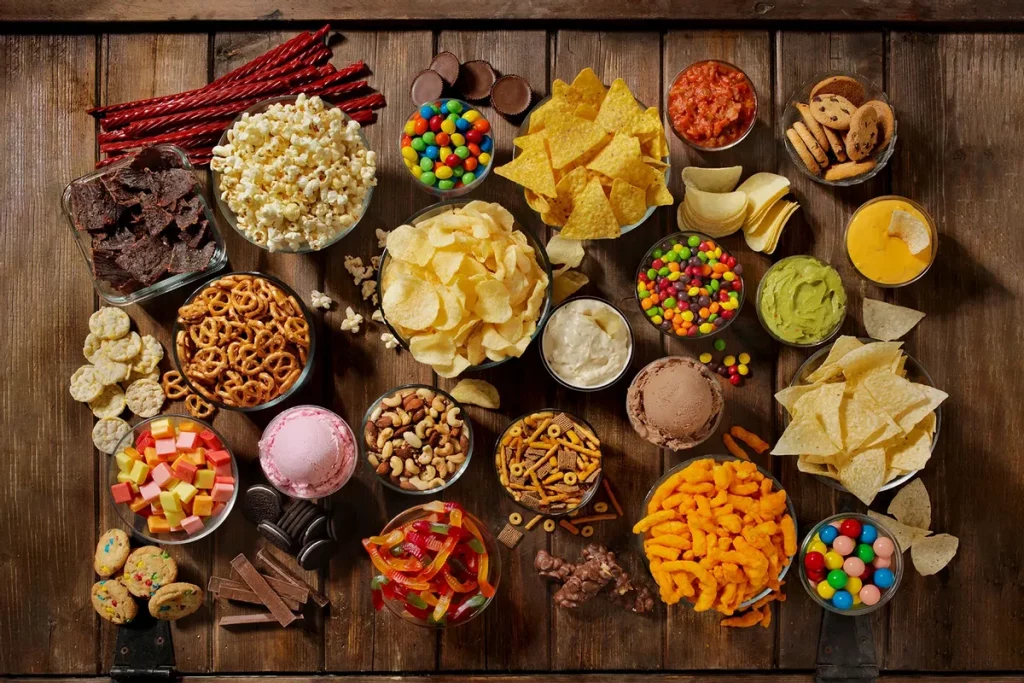
USDA Researchers Contend Ultra-Processed Foods Can Make Up 91 Percent of Healthy Diet
Food researchers allege study misleads the public about processed foods in the interest of ultra-processed food makers
Sheramy Tsai Jul 21 2023
A government-endorsed study that asserts a diet heavy in ultra-processed foods can remain balanced and nutritious has elicited sharp criticism among nutrition researchers who allege it confuses the public about one of the major health issues of our time: ultra-processed foods.
In a novel stance, scientists at the Agricultural Research Service’s Grand Forks Human Nutrition Research Center argue that ultra-processed foods can make up to 91 percent of a balanced diet. The preliminary study by the U.S. Department of Agriculture (USDA) contends that a diet predominantly comprising ultra-processed foods can score highly on diet quality and meet most macro and micronutrient requirements.
Julie Hess, an ARS research nutritionist and the study’s guiding force, encourages a shift in perspective—prioritizing food’s nutritional content over its processing level. This approach suggests that ultra-processed foods, which have traditionally been maligned in nutritional debates, can contribute significantly to a balanced diet.
In the study, scientists leveraged the widely used NOVA scale, first introduced in 2009, to classify foods by the degree of processing. As the dominant system in nutrition science, the NOVA classification system categorizes food based on the nature, extent, and purpose of its industrial processing. It includes four broad categories: unprocessed or minimally processed foods (fruit, whole-wheat flour); processed culinary ingredients (sugar, oil); processed foods (fresh bread, cheese); and ultra-processed foods (mass-produced bread with various additives, commercial salad dressings).
Ms. Hess voiced concerns over difficulties with the NOVA system because of potential ambiguities.
“There is not a consistent or easy-to-apply definition of what an ‘ultra-processed’ food is,” she told The Epoch Times.
Her claim has set off a tide of criticism from nutrition scientists. They maintain that the study overlooks abundant evidence connecting ultra-processed food intake to an elevated risk of various diseases, regardless of the food’s nutrient profile.
Carlos Monteiro, a key contributor to the development of the NOVA food classification system, disputes the study’s methodology and the authors’ application of the NOVA system.
“It is a desperate attempt to prevent the Dietary Guidelines for Americans (DGA) from mentioning ultra-processed foods since a recommendation against these foods would be beneficial for public health but detrimental to the profits of major corporations,” he told The Epoch Times.
Mr. Monteiro argues that the study miscategorizes certain foods as ultra-processed, thereby misrepresenting the NOVA system. He counters the assertion that ultra-processed foods are Americans’ primary affordable, nutrient-rich source, instead championing greater access to fresh and minimally processed foods.
Peeling Back Layers of USDA Research
For the study, USDA researchers sought to answer a straightforward question: Can ultra-processed foods be part of a healthy diet?
Your Health Matters
The researchers selected commonly consumed foods based on national survey data. They explain that they listed the ten most consumed foods in categories such as vegetables, fruits, or dairy and sought the ultra-processed version to assemble a diet.
“My lab wanted to include foods commonly consumed by Americans,” Ms. Hess said.
Researchers then called on external experts to evaluate an array of common foods. Their assessments relied on two main frameworks. One was the NOVA system, and the other was the DGA, which sets the standards for a healthy diet. Equipped with expert opinions and these guidelines, the researchers designed a weekly meal plan. Their target was a balanced diet of around 2,000 calories daily, aligning with the average adult’s energy needs.
The plan balanced ultra-processed items such as honey nut oat cereal, whole wheat rolls, and margarine with unprocessed foods such as eggs and broccoli. Despite falling short in vitamin D, vitamin E, and choline for certain age groups, the menu mirrored the Healthy Vegetarian Dietary Pattern’s nutrient profile in the DGA.
“Our study found that several nutrient-dense foods like whole wheat bread, nonfat milk, canned fruit, tofu, fruit juice, and canned fish could be considered ‘ultra-processed,’” Ms. Hess said.
The diet’s quality, as rated by the Healthy Eating Index-2015, was 86 out of 100, considerably higher than the average American score of 58 from HEI-2020. Due to excess sodium and inadequate whole grains, the menu didn’t achieve a perfect score.
Despite these findings, the researchers note some limitations in their study, stating, “This study exemplifies a possible healthy diet comprising mainly ultra-processed foods but does not necessarily use the most commonly consumed UPFs.”
Ms. Hess underscores the need for a clear definition of “ultra-processed.”
“Moving forward, a clear definition of ultra-processed foods and inclusion of nutrient density is needed before labeling ultra-processed foods as healthful or not.”
The authors propose that diets primarily filled with ultra-processed foods, as per the NOVA system, can fulfill nutritional standards and achieve high diet quality scores.
Food Scientists Push Back
The USDA study provoked a flurry of discussion in the nutrition science community and faces scrutiny from several researchers, including Mr. Monteiro. He raises concerns about the study’s unconventional approach and potential conflicts of interest.
“The authors are affiliated with soybean producer entities (an ingredient commonly found in ultra-processed foods) and other institutions connected to the food industry,” Mr. Monteiro said. “The U.S. is one of the largest consumers of ultra-processed foods in the world, and it is also home to major transnational corporations that profit from the sale of these foods.”
His critique extends to the methodological approach, which he refers to as “nutritionism.” He argues the study oversimplifies dietary health by focusing solely on individual nutrients, missing the broader picture.
“By simplistically analyzing a diet and considering only nutrients, the authors produce a false conclusion that it is possible to compose a healthy diet with ultra-processed foods,” he said. “In reality, they have not even been able to prove this hypothesis: the article itself highlights the excessive sodium and insufficient amount of whole grains.”
Mr. Monteiro challenges the study’s understanding of the NOVA classification, saying the authors cherry-picked “ultra-processed” foods that distort the intention of the NOVA scale, thereby mischaracterizing the term and implications of eating “unprocessed” foods.
“They attempt to do so by making a shallow comparison between nutrients in an ultra-processed diet and nutrients in a non-ultra-processed diet, but they fail to consider several crucial points in a study of this kind,” he said.
“They do not mention, for example, the impact of chemical additives in ultra-processed foods. They do not mention their addictive potential. They simply ignore the numerous pieces of evidence, including dozens of large, long-duration cohort studies and one randomized controlled trial, that link the consumption of ultra-processed foods with an increased risk of developing various diseases, independent of the dietary nutrient profile.
“It is a highly questionable study, even in terms of its methodology.”
He underscores that sporadic ambiguities in food categorization don’t undermine the comprehensive application of the NOVA system in worldwide research. Any such uncertainty was recently addressed in a Nature article, which offers scientists a guide on how to handle classification dilemmas for certain foods.
Mr. Monteiro insists the key responsibility to identify ultra-processed foods lies not with consumers but with public policies, education initiatives, or regulations. It’s a critical task that can’t be left to consumer guesswork, he said.
The study is further criticized for its alleged mischaracterization of ultra-processed foods. Monteiro clarifies that adding sugar to yogurt classifies it as processed, but not ultra-processed. It takes the inclusion of additional additives to reach that level. Similarly, whole-grain bread only ventures into the ultra-processed category when it contains nontraditional ingredients, such as emulsifiers or flavors.
“Accessibility and affordability are common characteristics of ultra-processed foods—and that’s exactly where the problem lies,” Mr. Monteiro said. “The focus should be on making fresh and minimally processed foods more accessible.”
He pointedly asked, “Who benefits from replacing fresh foods with ultra-processed options?”
Nutrition expert Marion Nestle shares Mr. Monteiro’s skepticism. In her blog, Ms. Nestle underscores the USDA study as an effort to “cast doubt on the concept of ultra-processed foods (UPF)” and research demonstrating their association with poor health outcomes.
She asserts, “I think the UPF concept is so solidly backed up by evidence that it is here to stay.”
Ms. Nestle further suggests that the USDA’s Agricultural Research Service is conflicted, arguing that it functions as a “marketing arm of the food industry.” Her criticism of the Healthy Eating Index used in the USDA study aligns with Mr. Monteiro’s, noting its focus is purely nutrient-based and not fully equipped to address the issue of ultra-processed foods, which contain additives such as stabilizers, coloring agents, and sweeteners that are linked to disease-causing biological effects.
In addition to the scrutiny from these prominent academics, the USDA study has sparked discussion among the broader scientific community. One voice chiming in is Kevin Hall, a scientist at the National Institutes of Health, who took to Twitter on July 12 to express his reservations.
“Interesting that @USDA is actively promoting to the public (via press release) a diet very high in ultra-processed foods as being ‘healthy’ despite its high Na [sodium] content and without the diet actually ever being tested in people,” he wrote.
Evidence on Health Risks of Ultra-Processed Foods
Ultra-processed foods, industrial creations transformed into easy-to-consume, appetizing meals with long shelf life, have become a significant part of the American diet. These products now comprise a substantial 60 percent of the average adult’s food intake.
There is a widespread lack of understanding about what constitutes ultra-processed foods among the general public. A survey from September 2022 by the International Food Information Council reveals that 76 percent of Americans are in the dark about the classification of ultra-processed foods.
Many consumers are quick to label soda and packaged baked goods as ultra-processed. Yet, some undercover ultra-processed items such as ketchup, certain plant-based milks, and flavored yogurts slip under the consumer’s radar.
“There are a lot of foods that may be marketed or thought of as healthy, but have actually been processed quite a bit,” said Dr. Neha Sachdev, a family physician and director of health systems at the American Medical Association. “It’s important to be aware of the foods you’re eating on a regular basis and how processed these foods are.”
Science continues to uncover the health risks linked to a diet rich in ultra-processed foods. A 2022 study in BMJ involving nearly 23,000 people found that those frequently dining on ultra-processed foods faced higher risks of heart disease and death from all causes. Another revealing piece from BMJ that same year raised alarm bells, suggesting that ramping up consumption of ultra-processed foods might stoke the fires of colorectal cancer risk.
Our brains aren’t fans of these foods either. Studies reveal that a mere 10 percent shift from ultra-processed to less or unprocessed foods could catalyze a significant 19 percent drop in the risk of dementia.
“It is important to highlight that calories are not all created equal,” Dr. Sachdev said. “The same calories that you might get from eating an apple, for example, are very different than the calories you might get from eating an apple fruit bar. These might be equivalent in number, but what ultra-processed calories represent and the nutrition that they provide your body is different.”
Yet, in spite of the concerns raised, the authors of the USDA study maintain that ultra-processed foods have a role in nutrition, particularly for specific demographics. They suggest that these foods, due to their accessibility and convenience, could provide a nutritional fallback in some cases.
“Some key points often omitted from the ultra-processed food discussion are the potential benefits these foods can offer as nutrient-rich options,” Ms. Hess said. “They can be a viable choice for individuals on a tight budget, families, people with limited grocery access, frequent travelers, and others.”

